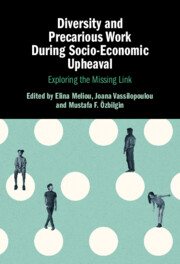Book contents
- Diversity and Precarious Work during Socio-economic Upheaval
- Diversity and Precarious Work during Socio-economic Upheaval
- Copyright page
- Contents
- Figures
- Contributors
- 1 Introduction
- 2 Pandemic Precarities and Gendered Biopolitics within the Neoliberal University
- 3 LGBTQ+ Individuals and Precarious Work
- 4 Age, Gender, and Precarity
- 5 How the (In)Ability of Using One’s Disability Strategically Reinforces Inequality and Precariousness amongst Disabled Workers
- 6 Classed and Gendered Experiences of Precarity in Dirty Work
- 7 Precarity and Diversity
- 8 Precarious Work in the Gig Economy
- 9 Refugees’ Vulnerability towards Precarious Work
- 10 Trapped in Precarious Work
- 11 How Precarity Is Threaded into Migration Rules
- 12 Culture, Precarity, and Dignity
- 13 Transforming Humanitarianism
- 14 Artificial Intelligence, the Gig Economy, and Precarity
- Index
- References
14 - Artificial Intelligence, the Gig Economy, and Precarity
Published online by Cambridge University Press: 01 February 2024
- Diversity and Precarious Work during Socio-economic Upheaval
- Diversity and Precarious Work during Socio-economic Upheaval
- Copyright page
- Contents
- Figures
- Contributors
- 1 Introduction
- 2 Pandemic Precarities and Gendered Biopolitics within the Neoliberal University
- 3 LGBTQ+ Individuals and Precarious Work
- 4 Age, Gender, and Precarity
- 5 How the (In)Ability of Using One’s Disability Strategically Reinforces Inequality and Precariousness amongst Disabled Workers
- 6 Classed and Gendered Experiences of Precarity in Dirty Work
- 7 Precarity and Diversity
- 8 Precarious Work in the Gig Economy
- 9 Refugees’ Vulnerability towards Precarious Work
- 10 Trapped in Precarious Work
- 11 How Precarity Is Threaded into Migration Rules
- 12 Culture, Precarity, and Dignity
- 13 Transforming Humanitarianism
- 14 Artificial Intelligence, the Gig Economy, and Precarity
- Index
- References
Summary
In this chapter, we explore the duality of the artificial intelligence (AI)–enabled gig economy in terms of the precarity and the promise it offers. In particular we focus on underrepresented and disadvantaged groups of workers who found new homes in the AI-enabled gig economy. We explore how their precarity is viewed in the extant literature. We then expose the lack of attention to this group of workers, whose exclusion from the traditional labour market was not originally problematised, who now are portrayed as suffering as a result of poor regulation of AI. As such we expose the hypocrisy in terms of how precarity is problematised with the development of AI-enabled gig economy and yet the potential of the gig economy to open up opportunities for atypical workers is often overlooked. One of the concerns that we observe is the over-representation of the atypical workers in the sector. We demonstrate that it is possible to have an AI-enabled gig economy which does not lead to precarity, if there is effective regulation of the sector. We provide a brief roadmap with multilevel regulatory controls for combatting precarity in the AI-led gig economy.
Keywords
- Type
- Chapter
- Information
- Diversity and Precarious Work During Socio-Economic UpheavalExploring the Missing Link, pp. 284 - 305Publisher: Cambridge University PressPrint publication year: 2024
References
- 1
- Cited by



